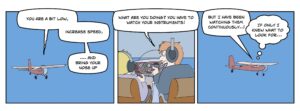
At the heart of any consideration of questions of controllability and resilience is the question of degrees of freedom. This was a central question of concern for Nikolai Bernstein in his explorations of perceptual-motor skill. In the context of motor skills, degrees of freedom refer to the constraints/possibilities for moving our bodies. But more generally - one might think of the degrees of freedom in a system as setting bounds on the potential for action. When degrees of freedom are high - then there will be many different ways to accomplish the same task or goal.
Generally, the more degrees of freedom a system has - the more resilient it can be. This is because when one route to a goal is blocked, there will be other paths for reaching that goal. However, degrees of freedom pose a challenge for control - because the more degrees of freedom a system has - the more variables have to be taken into account in the control logic. In essence, increasing the degrees of freedom increases the potential for disturbances that have to be managed by the controller.
So, the degrees of freedom problem refers to a trade-off between flexibility (resilience potential) and control complexity. More degrees of freedom means there are more ways to be successful in accomplishing a goal, but also more ways to fail. In the context of perceptual motor control, the constructs of coordinative structure and smart mechanism were introduced as hypotheses of how to effectively manage this trade-off.
A coordinative structure or smart mechanism is created by constraining or locking out a subset of the degrees of freedom to create a simpler 'mechanism' (less complex control problem) that is specialized for a particular task or situation. This is somewhat analogous to the smart heuristics described by Gerd Gigerenzer in relation to ecological rationality.
The skill of golf provides a good example of how skilled athletes manage the degrees of freedom problem. Trying to drive a golf ball is a difficult control problem because of the many degrees of freedom in the body. For example, there are many potential disturbances to the path of the club head during a swing - a bend at the elbow of the leading arm, a twist of the head or shoulder, the positions of the legs, etc. It is simply impossible for a person to control all of the different degrees of freedom in real time. So, learning to drive a golf ball consistently involves learning to lock out many of the degrees of freedom (e.g., locking the elbow of the leading arm, holding the head in a fixed position with eyes on the ball, etc.). Thus, pro golfers learn to become a simple 'driving machine' that involves realtime control of only a few degrees of freedom that are specifically chosen to generate power to hit the ball great distances in a specific direction.
So, what good is having a lot of degrees of freedom if we are going to lock them out. The high degrees of freedom allows golfers to become many different kinds of simple mechanisms. They can lock out a different set of degrees of freedom to become a chipping mechanism, designed to hit a ball with greater control over distance and direction. Or they can lock out another set of degrees of freedom to become a putting mechanism. Thus, a pro golfer will learn to become many different simple control mechanisms that are specialized for different situations they will face on a golf course. Successful golfers not only have different types of golf clubs - but also have specialized control mechanisms that have been 'designed' through extensive practice for specific situations.
Thus, to be resilient it is desirable for organizations to maximize degrees of freedom to increase the space of potential possibilities or to increase the possible routes to satisfying ends. However, the organizations also need to develop (train) smart mechanisms tuned to the demands of different situations - so that they will not be overwhelmed by the need to control too many variables in realtime. And they have to learn to choose the right mechanism for the right situation. Just as smart heuristics reduce the computational burden, while maintaining high levels of effectiveness with regards to decision making, smart mechanisms reduce the computational demands on control, while maintaining high levels of effectiveness with respect to coordinated action.
